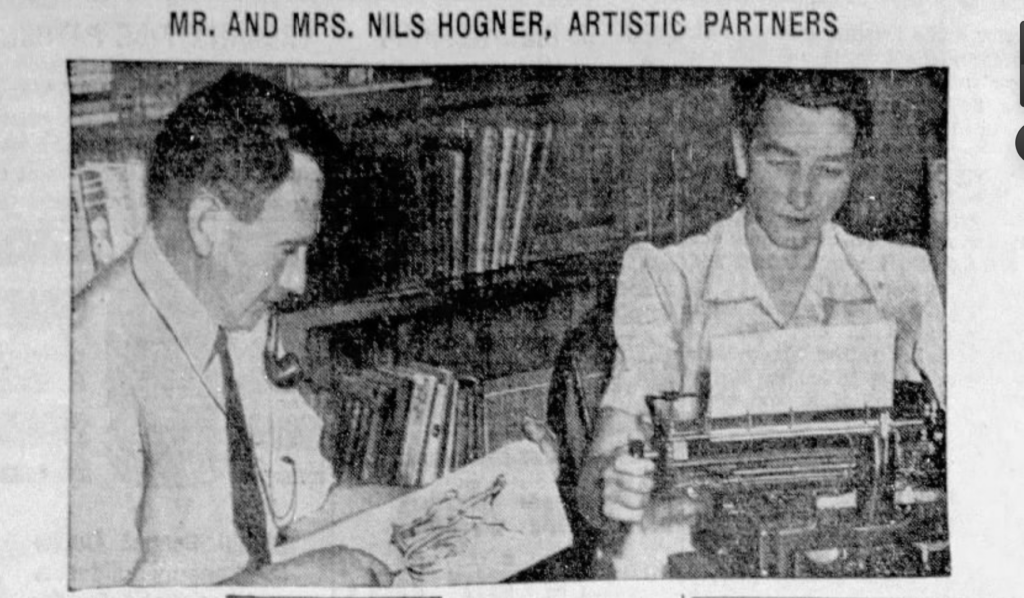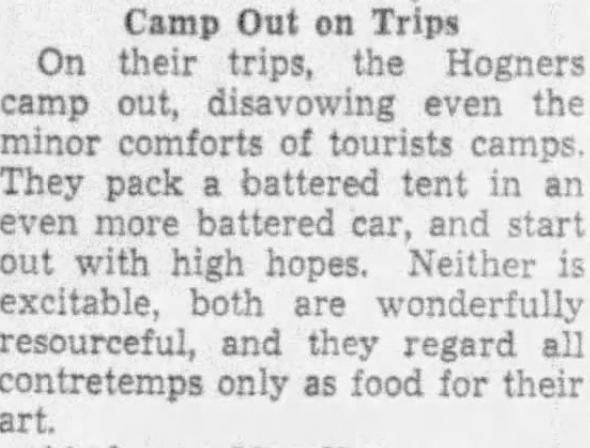
I was researching an herb topic and decided to search through books on my bookshelf because the internet was not giving me what I was looking for. I discovered two things.
First, I don’t have that many books on herbs.
And second, in the herb books I do have I found Dorothy Childs Hogner, another lost lady of garden writing.
I realized with one search that Dorothy didn’t start out writing gardening books and is probably better know for her children’s books, both fiction and non-fiction, many related to travel.
But she did write several gardening books and I had never heard of her, so she can be a lost lady of garden writing too.
I have one of her gardening related books, A Fresh Herb Platter (1961), which, like many of her books was illustrated by her husband, Nils Hogner. It includes gardening advice followed by recipes for vegetables and herbs. She notes in the introduction that she considers it “sacrilege” when gardeners don’t cook the vegetables and herbs they grow but instead let others do that cooking.
Through various internet searched, I found several other gardening books she wrote including Gardening & Cooking on Terrace and Patio (1964), Herbs from the Garden to the Table (1953) and Good Bugs and Bad Bugs in Your Garden: Back-Yard Ecology (1974).
Amongst her children’s books, she wrote Winky: King of the Garden (1946). “Winky is a scarecrow but doesn’t know what a crow looks like. When a crow does appear, Winky is more terrified than the crow. With the help of a rabbit, squirrel, woodchuck, and mouse, Winky overcomes his fear and becomes king of the garden.”
Gosh that sounds like a fun book to read!
Finding biographical information about Dorothy wasn’t that easy. To figure out some of it, I had to look up information about her husband Nils and then work back through that to find Dorothy.
What I did figure out is that Dorothy was born July 16, 1904, in Manhattan, and died June 6, 1989 in Litchfield, CT. (Her husband, Nils, was born in 1898 and died in 1970.) They had an herb farm in Litchfield called Hemlock Hill Herb Farm.
The picture above of them working together is from the Albuquerque Tribune, August 1939, for an article that talks about their working partnership.
Reading the article, I learned that Dorothy “studied at Wellesley and then went to New Mexico to write a children’s book on the Sante Fe Trail.” That’s where she met and married Nils, around 1932. Dorothy and Nils worked happily together until his death in 1970. They had no children but Nils had a son with his first wife.
They liked to travel. Dorothy is listed on several passenger lists for ships going to and from Europe in the 1920s. The article I read also mentions how they enjoyed traveling and camping, in both the southwestern United States and Canada. About their camping, the author of the article wrote:

I don’t think anyone thought to write an obituary for Dorothy when she died in 1989, or at least I can’t find one. That seems odd considering she was the author of over 50 books. She’s not even listed in Wellesley College’s top 100 alumni, which admittedly is quite the list, but I don’t know if she actually graduated or just attended.
Be that as it may, if anyone else searches for Dorothy, at least now they might find this blog post where I’ve gathered most of what I could find out. She’s a welcome addition to my occasional posts on lost ladies of garden writing.


Hello.
I loved Elisabeth Bailey’s book “The Sound of a Wild Snail Eating “ and happened to share it with my Aunt who grew up in Litchfield CT and whose mother (and my Grandfather) were good friends of Dorothy and Nils Hogner. My aunt immediately recognized Elisabeth Baileys reference to Dorothy Hogner and shared with the family 🙂
I just received from one of my Aunt’s sisters this link and thought you would like to read this intro in one of her books by Dorothy …
Best wishes,
Elise
“Nils Hogner, author of Farm for Rent (see illustration above), was born in Massachusetts to Swedish immigrant parents. He attended Rhodes Academy, Copenhagen, Denmark, Royal Academy of Arts, Stockholm, Sweden, Boston School of Painting, and the School of the Museum of Fine Arts, Boston. He married Dorothy Childs, an author, in 1932. They purchased Hemlock Hill Herb Farm in Litchfield and remained part-time residents throughout their lives. Dorothy Childs Hogner’s book The Wild Little Honker is also on display. She wrote many books illustrated by her husband Nils.
Dorothy Childs Hogner wrote of her Litchfield Home in the introduction for the second edition of The Junior Book of Authors, 1951.
We enjoy the city and like living here in winter, but, perhaps even more, we enjoy our camp in Connecticut, where we go in summer.
In winter we drive up there quite often to feed the birds. We have about eleven acres of woodland, in a remote spot, and when the snows are heavy we have to walk through drifts to get there. The birds are always glad to see us, the chickadees, the nuthatches, the juncos, and even the wild shy grouse, which will come out and eat corn when we are there, if we sit very quietly inside, looking out of the window.
Of course, these birds, and all the wild animals which live there, the chipmunks, squirrels, rabbits, and others, make wonderful characters for our books. We have put up a salt lick too, so the deer come near our back porch, and sometimes we catch a glimpse of a fox, or of the handsome shy lynx cat which lives in the near-by forest.
There is only one animal we do not find amusing. That is the woodchuck. We liked him at first, but he is such a glutton. He enjoys filling himself on greens we plant in our garden, and we are both very fond of gardening. So we and the woodchucks do not get on!”
I’ll have to send the link in another comment …
Here is the link to the site talking about Dorothy and Nils Hogner:
https://blog.litchfieldhistoricalsociety.org/?p=487
Hi,
Dorothy wrote a book about her camping trips with Nils in the West, called Westward High Low and Dry. Published by E P Dutton in 1938. My daughter found a copy in a free library, and we enjoyed reading about what the western deserts were like in the mid ’30s.
Being an amateur entomologist, I am constantly looking in second-hand shops for books on the subject of insects and gardening. In our local Friends of the Library Used Book Depot, I stumbled upon Dorothy Childs Hogner’s “Good Bugs and Bad Bugs in Your Garden Back-Yard Ecology”, from 1974! This is the stuff we are teaching through UF/IFAS Extension in our counties throughout Florida. And we think its all new. Ha! We gardeners knew about the Good and the Bad from way, way back. I was curious as to other books by this author and thought to search the internet for her name. You are right, there is not much out there about Mrs. Hogner. I will now keep my eye open for some more of her clever books as all of her topics are of interest. Just see what a little time away from the screen can help you accomplish.
What’s old is new, as they say!
Thank you for all the information about Dorothy Childs Hogner and her husband Nils Hogner. They sound like they had such fun camping, gardening and enjoying nature! I was looking for information on her because I loved her beautifully-illustrated children’s book, “Blue Swamp”, about a group of small animals who lived on the edge of a swamp where they were afraid of the will-o-the-wisp, and how they faced their fears.
You are welcome. I also wrote about her on Substack: https://lostladiesofgardenwriting.substack.com/p/dorothy-childs-hogner